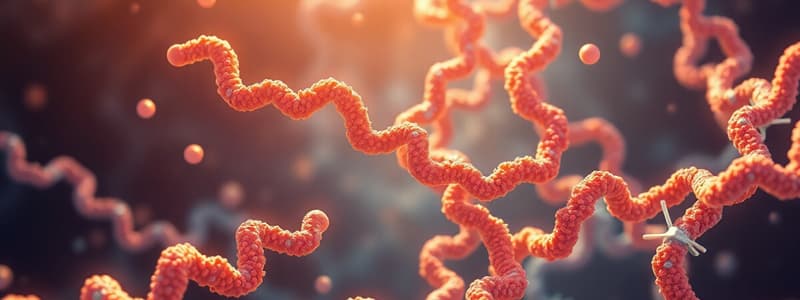Podcast
Questions and Answers
What is the primary role of R groups in amino acids?
What is the primary role of R groups in amino acids?
- To carry out the chemical reactions of the protein
- To determine the color of proteins
- To influence the sequence of the polypeptide chain
- To specify the amino acid's solubility properties (correct)
Which type of amino acids must be obtained through diet?
Which type of amino acids must be obtained through diet?
- Polar amino acids
- Non-essential amino acids
- Charged amino acids
- Essential amino acids (correct)
What process involves the formation of peptide bonds?
What process involves the formation of peptide bonds?
- Dehydration synthesis of amino acids (correct)
- Secondary folding of polypeptides
- Hydrolysis of proteins
- Denaturation of proteins
Which structure of a protein is characterized by the overall 3D shape formed by interactions between R groups?
Which structure of a protein is characterized by the overall 3D shape formed by interactions between R groups?
What are chaperones primarily responsible for?
What are chaperones primarily responsible for?
What happens to proteins during denaturation?
What happens to proteins during denaturation?
Which of the following correctly describes polar amino acids?
Which of the following correctly describes polar amino acids?
Which of the following levels of protein structure involves the assembly of multiple polypeptide chains?
Which of the following levels of protein structure involves the assembly of multiple polypeptide chains?
What typically causes misfolding of proteins?
What typically causes misfolding of proteins?
What is the significance of the primary structure of a protein?
What is the significance of the primary structure of a protein?
Flashcards are hidden until you start studying
Study Notes
Proteins
Amino Acids
-
Basic Structure: Building blocks of proteins; consist of:
- Amino group (-NH2)
- Carboxyl group (-COOH)
- Hydrogen atom
- R group (side chain, varies among different amino acids)
-
Types:
- Essential Amino Acids: Cannot be synthesized by the body; must be obtained from diet (e.g., leucine, lysine).
- Non-essential Amino Acids: Can be synthesized by the body (e.g., alanine, aspartic acid).
-
Properties:
- Polar vs. Non-polar: Determines solubility; polar amino acids are hydrophilic, non-polar are hydrophobic.
- Charged vs. Uncharged: Charged amino acids participate in ionic bonds; important for protein structure.
-
Peptide Bonds:
- Formed between amino acids through dehydration synthesis.
- Create polypeptide chains; the sequence determines protein function.
Protein Folding
-
Definition: The process by which a linear polypeptide chain folds into a specific three-dimensional structure.
-
Importance:
- Determines the protein's function; misfolded proteins can lead to diseases (e.g., Alzheimer's, cystic fibrosis).
-
Folding Process:
- Primary Structure: Sequence of amino acids in the polypeptide chain.
- Secondary Structure: Local folding into alpha-helices and beta-sheets stabilized by hydrogen bonds.
- Tertiary Structure: Overall 3D shape formed by interactions between R groups (e.g., hydrophobic interactions, ionic bonds, disulfide bridges).
- Quaternary Structure: Assembly of multiple polypeptide chains into a functional protein complex.
-
Chaperones:
- Proteins that assist in the proper folding of other proteins; prevent aggregation and misfolding.
-
Denaturation:
- Process where proteins lose their functional shape due to external stress (e.g., heat, pH changes).
-
Folding Pathways:
- Often involves intermediate states; may require energy input to reach the lowest energy conformation.
Amino Acids
- Basic units that comprise proteins, characterized by an amino group (-NH2), carboxyl group (-COOH), hydrogen atom, and a variable side chain (R group) that distinguishes different amino acids.
- Essential amino acids cannot be made by the body and must be sourced from food (e.g., leucine, lysine).
- Non-essential amino acids can be synthesized by the body (e.g., alanine, aspartic acid).
- Amino acids classified as polar are hydrophilic (water-attracting), while non-polar amino acids are hydrophobic (water-repelling).
- Charged amino acids are crucial for forming ionic bonds that help stabilize protein architecture.
- Peptide bonds link amino acids via dehydration synthesis, leading to the formation of polypeptide chains, with the sequence dictating protein function.
Protein Folding
- The process where a linear polypeptide adopts a specific three-dimensional shape essential to its function.
- Correct folding is critical; misfolded proteins can cause serious diseases such as Alzheimer's and cystic fibrosis.
- Primary structure refers to the linear sequence of amino acids in the protein.
- Secondary structure involves localized folding patterns, such as alpha-helices and beta-sheets, stabilized by hydrogen bonds.
- Tertiary structure represents the overall three-dimensional configuration formed by interactions among R groups, including hydrophobic interactions and ionic bonds.
- Quaternary structure is formed when multiple polypeptide chains assemble into a functional protein complex.
- Chaperones are specialized proteins that facilitate correct protein folding, preventing aggregation and misfolding.
- Denaturation occurs when proteins lose their functional shape due to external factors, like extreme heat or pH changes.
- Folding pathways can contain intermediate states and often need energy to achieve the most stable (lowest energy) conformation.
Studying That Suits You
Use AI to generate personalized quizzes and flashcards to suit your learning preferences.




